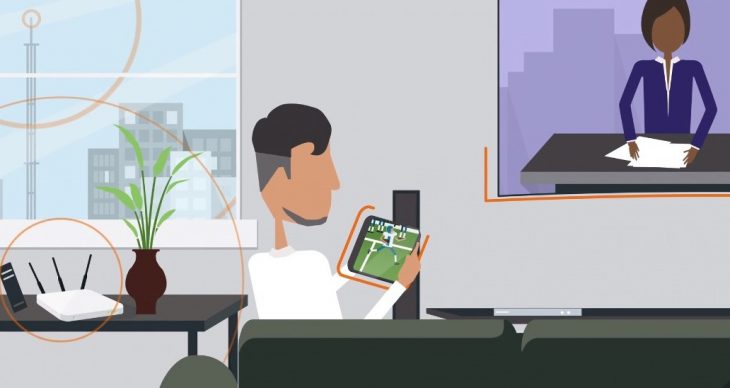
LAS VEGAS – With the official introduction of the new ATSC 3.0 broadcast TV transmission standard last month and two pilot market launches last week, U.S. broadcasters are abuzz about the potential of transforming their stations into IP-based powerhouses. Now the big question is how quickly will the stations roll out the new transmission standard throughout the nation and what will they do with it.
The ATSC (Advanced Television Systems Committee) 3.0 standard, championed by broadcasters, emergency alert groups and consumer electronics makers, will let over-the-air TV stations to deliver targeted advertising and alerts, video-on-demand services, interactive features, 4K UHD TV and other IP-based services. Among other things, industry watchers expect the new standard to drive sales of 4K TV sets because it will enable the delivery of higher-resolution pictures to homes, without the need of a subscription TV provider.
Thanks to these benefits, broadcasters believe that they will be better able to compete with pay-TV providers, OTT video providers and especially Internet players for viewers, advertisers and revenue. Not surprisingly, then, many of them have been chomping at the bit to start rolling out the standard even though it means spending more capital upfront to upgrade their delivery systems and equipment.
Capitol Broadcasting, a Raleigh, NC local broadcaster that has often pioneered next-generation TV services like HDTV, has already kicked the tires on ATSC 3.0. In February, Capitol's WRAL-TV station conducted a test that delivered the first Winter Olympics broadcast in 4K UHD in the U.S.
Now other local broadcasters are getting into the act. Just last week Univision Communications launched a pilot market trial of ATSC 3.0 in the Phoenix area, with other Phoenix TV stations expected to follow shortly. Similarly, Dish, Sinclair Broadcasting and Spectrum Co., a consortium of local broadcasters, launched a market trial of the technology in Dallas last week. ATSC 3.0 trials are also taking place in the Cleveland market.
If all goes well with the field trials, U.S. broadcasters could start rolling out the technology commercially by the end of this year, following the 2017 lead of their counterparts in South Korea. Unlike the introduction of the digital TV transmission standard nearly a decade ago, the ATSC 3.0 rollout will be completely voluntary by stations so there is no exact timetable for the industry. (Ed note: We don’t yet know what Canadian broadcasters plan to do with the ATSC 3.0 capabilities, should they choose to deploy, but you can we sure we’re asking.)
Once they start introducing ATSC 3.0 in their markets, broadcasters will have to simulcast their signals in both the new standard and the current ATSC 1.0 standard with in-market TV station partners for five years because the next-gen standard is not backward-compatible with the old standard. The FCC established the five-year window to give consumers time to upgrade their TVs and set-top boxes so they can continue to view over-the-air programming.
With all this market activity about to unfold, there were more than 40 exhibitors of ATSC 3.0 technology at the NAB Show here last week, touting their products and services. And the main lobby of the Las Vegas Convention Center featured a huge “Road to ATSC 3.0” exhibit that showcased the deployment plans for ATSC 3.0 in cities throughout the U.S. and the rest of the world.
“With approval of the ATSC 3.0 suite of standards, the focus shifts from development of the standard itself to early deployments across the world.” – Mark Richer, ATSC
“With approval of the ATSC 3.0 suite of standards, the focus shifts from development of the standard itself to early deployments across the world,” said ATSC president Mark Richer. He ticked off the 4K broadcasts of the Winter Olympics by South Korean stations and the initial U.S. market trials and pilot deployments in Cleveland, Raleigh, Phoenix and Dallas as prime examples.
Although it has ruled on most of the major issues, the FCC still has a few decisions left to make about how broadcasters will roll out ATSC 3.0 service in their markets. In addition, three parts of the FCC's rules will not take effect quite yet because they require information collection that must be approved by other government agencies,
More technical work must also be done on the 3.0 standard to refine it further, according to Richer. Nevertheless, the formal standard is now out there and the race to deploy next-gen TV has officially begun.
In the meantime, broadcasters are fighting a rear-guard regulatory action in Washington, D.C. against cable operators seeking to clarify and modify the simulcast signal requirements. Cable operators are concerned that the combination of the new simulcast requirements and the current broadcast retransmission-consent rules could end up forcing them to carry broadcasters' ATSC 3.0 signals just to get some must-have programming, cluttering up their channel lineups. So cable lobbying groups are urging the FCC to reconsider the simulcast rule, as well as asking the Commission to keep broadcasters from reserving spare channel space for ATSC 3.0 signals.
In their latest petition to the FCC, the cable groups argue that allowing broadcasters to bundle their old and new signals into re-trans deals “shifts the costs and burdens of this new standard onto cable operators and the viewing public.”
For their part, broadcasters have called on the FCC to dismiss the cable petitions as "regulatory arbitrage," contending that their adversaries are simply rehashing positions that were already rejected by the Commission. In its latest filing in the case earlier this week, NAB declared that the cable flings were "not so much petitions for reconsideration as they are airings of grievances" and urged the agency to reject them.



